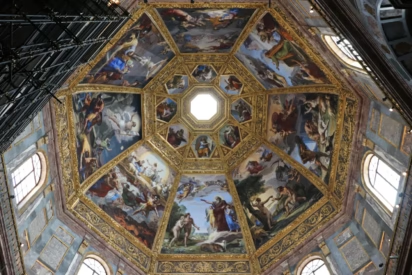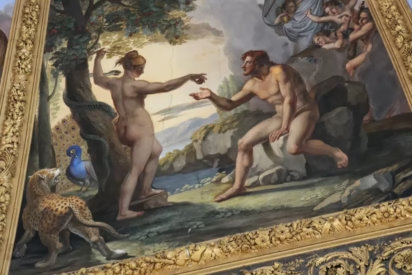The Medici Chapels with Michelangelo sculptures in the San Lorenzo church complex form the mausoleum for the most powerful and best-known family in Renaissance Florence.

The mausoleum of the Medici family in Florence is not surprisingly a grand affair. The second largest cupola in Florence covers the huge Chapel of the Princes (Capella Dei Principi) while colorful marble and precious stones decorate the walls in High Renaissance opulence. For many, the main reason to visit is to see the sculptures by Michelangelo in the New Sacristy. Although Michelangelo abandoned the project only half done, the Medici Chapels still have the largest number of sculptures by Michelangelo in Florence.
Time-slot reservation tickets are sensible during the high season. Guided tours are available.
→ Top museums, churches, and sights in Florence are open mostly as normal in 2025 — see 2025: Florence Opening Hours of Top Sights, Museums, and Churches for the latest information and opening hours. The Firenzecard is again sold while the Turbopass Florence City Pass is a good alternative that includes online timeslot reservations for both the Uffizi and Accademia.
Mausoleum Chapels of the Medici Family in Florence

San Lorenzo was the local parish church of the Medici family — for centuries the most powerful and richest family in Firenze. A visit to the Cappelle Medicee includes three main sights: the crypt, the chapel of the princes, and the new sacristy. (The Secret Room of Michelangelo is separate — the expensive tickets are very hard to book.)
Further Medici tombs are in the old sacristy and in the crypt under the crossing of the main church — these are seen as part of a visit to the San Lorenzo basilica.
Admission to the Medici Chapels, which in contrast to the main church is a national museum, is from the Piazza di Madonna degli Aldobrandini on the northeast side of the San Lorenzo basilica. Opening hours and admission tickets are completely separate from the rest of the San Lorenzo complex.
Old Crypt of the Medici Mausoleum in Florence
Tourists enter directly into the old crypt (Crypte del Buontalendti) with the remains of the Medicis. The monumental sarcophagi elsewhere in the complex are usually empty. Many of the memorial slabs here are only from the 19th century when the crypt was somewhat tidied up — minor Medicis often did not receive any special funeral monuments.
The dusty displays here are mostly unimportant — the highlights of the visit are the two chapels that follow.
Chapel of the Princes in San Lorenzo
The monumental Capella Dei Principi Chapel is the main mausoleum for the Medici family. It was commissioned by Cosimo I in 1568 but construction only started in 1602 after a design by Matteo Nigetti’s was selected.
Construction dragged on and the chapel was only completed in the 20th century long after the once illustrious family became extinct. Anna Maria Luisa de’ Medici (1667-1743), the last Medici, decreed that the chapel should remain open to the public for eternity. (She also left much of the Uffizi gallery, other art, and palaces to the state.)
The octagonal chapel is 28 m wide but an impressive 59 m high. It is this cupola, rather than the crossing of the nave and transept of the basilica that is the most recognizable feature of the church when viewed from a distance.
The walls of the chapel are clad with polychrome marble and precious stones to leave no area unadorned. The material used in the decorations includes marble, multicolored granite, jasper, alabaster, and lapis lazuli, and even coral and mother-of-pearl. The six monumental sarcophagi are empty and only two of the planned six portrait sculptures were ever completed.
The effect is in stark contrast to the elegance of the early Renaissance bare walls Brunelleschi preferred for the nave and old sacristy of San Lorenzo. The High Renaissance chapel of the princes reflected the taste of the period and the Medicis liked the effect enough to use the chapel as a reception room for dignitaries and for wedding celebrations.
Cupola of the Chapel of the Princes
The cupola painting is by Pietro Benvenuti (1828) — the original plans called for a simpler but lavish lapis lazuli cover. Note the smaller details in some of the panels, such as the parading peacock and leopard in the Garden of Eden.
Among the items in the odd display cases are a papal tiara and staff used by Pope Leo X, a Medici. Also on display is a very impressive “Bandinella” — a processional banner adorned with the Medici coat of arms and a gift from Pope Leo to San Lorenzo. It is 500 years old.
Michelangelo’s New Sacristy in San Lorenzo

A narrow passage leads to the new sacristy (Sagrestia Nuova) designed by Michelangelo, as his first architectural project in 1519 on commission from Pope Clement VII, the second Medici pope. It is at the opposite end of the transept to the old sacristy by Brunelleschi, which has tombs of even earlier Medicis but is accessible for visitors from inside the Basilica of San Lorenzo.
Michelangelo Sculptures in the Medici Chapels

The new sacristy was supposed to have four monumental grave monuments but as Michelangelo left for Rome in 1534, the project was left incomplete. As a result, the two completed monumental tombs are for two relatively unimportant members of the Medici family:
Lorenzo (1492-1519), Duke of Urbino and nephew of Pope Leo X, is portrayed by Michelangelo in deep thought, as Machiavelli’s Prince. The allegories on the sarcophagus are a rather muscular female Dawn waking from sleep and a tired Dusk about to fall asleep. The face of the male Dusk is rather rough to emphasize tiredness.
Guiliano (1478-1516), Duke of Nemours and brother of Pope Leo X, is portrayed by Michelangelo as a military captain. He is flanked by the reclining statue of Day — a powerful male with an unfinished face — and Night, a young sleeping woman with a head inspired by classic Greek sculptures.
Sepulcher for Lorenzo the Magnificent

A Madonna and Child by Michelangelo decorates the sepulcher for Lorenzo the Magnificent (died 1492) and his brother Giuliano (killed during the Pazzi conspiracy in 1478). The intended more elaborate tombs were never created.
Vasari placed statues of the Medici patron saints on either side in 1554: on the left Saint Cosmas by Giovan Angelo da Montorsoli and on the right Saint Damian by Rafaello da Montelupo. Both sculptors were pupils of Michelangelo.
In the passage leading to the new sacristy are two military trophies by Silvio Cosini, a further pupil of Michelangelo. These were intended as part of the decorations for the New Sacristy but were never installed as Michelangelo abandoned the project when moving to Rome in 1534.
Visitor Information for the Medici Chapels in Florence
The Medici Chapel is a state museum meaning opening hours and tickets are completely independent from the other sights in the San Lorenzo complex.
Opening hours of the Medici Chapel are 8:15 to 18:50 from Wednesday to Monday. The chapel is closed on Tuesdays, 25 December and, 1 January.
The Medici Chapel is part of the Bargello Museum and it is sensible to double-check opening times for specific days — sometimes it is open for shorter in winter.
Admission to the Medici Chapels is fairly pricy at €9 (free for under 18s, €2 for EU nationals 18 to 25). It is possible to see more sculptures for less in the Bargello but the Medici Chapel has the largest number of Michelangelo sculptures in Florence.
Time-slot reservations are possible and worth the extra charge during the high season. Guided tours are also available and often include further Medici sights in Florence.
The Firenze Card is valid at the Medici Chapel as a skip-the-line ticket — go straight to the entrance after the security check.
Tickets to see the secret room of Michelangelo (“Stanza segreta di Michelangelo”) are €32 with reservations absolutely essential. Only 4 visitors are allowed in every 15 minutes and tickets still sell out weeks and months in advance.
A combination ticket with all Bargello-managed museums in Florence is worth considering: this €24 Biglietto Cumulativo Musei del Bargello gives access to the Bargello, Cappelle Medicee, Davanzati, Orsanmichele, and Casa Martelli within 72 hours — check the different closing dates to avoid missing out. (An annual pass is €50 and offers further discounts.)
The Medici Chapel is open for free on the first Sunday of the month. On free admission days, no entry tickets or reservations are possible. Queue up at the entrance.
More Articles on Florence Sights
The high season in Florence is increasingly long: Easter, May, July, August, and the Christmas holidays are especially busy. November and January to mid-March are the only quiet months, except for the February school holiday week. Plan and book time-slot reservation tickets and tours when available in advance — the Accademia and the Uffizi are again sold out weeks in advance. Top sights are quieter directly at opening time or in the late afternoon.
→→ Opening hours for top sights in 2025 — most sights have long hours but advance time-slot reservations are always sensible.
- Tips on Buying Tickets for the Uffizi Museum
- Tips on Buying Skip-the-Line Tickets for the Accademia (Michelangelo’s David)
- See Michelangelo’s David in the Galleria dell’ Accademia
- Visit the Duomo sights: Cathedral (Duomo), Baptistery (Battistero), Bell Tower (Campanile), Dome (Cupola), Museum (Museo), and Tickets + Opening Hours
- Visit the Bargello Museum of Sculpture (Donatello’s Davids)
- Visit San Marco Museum to see the frescoes and altarpieces painted by Fra Angelico.
- Visit Santa Maria Novella Church and Museum to see medieval and Renaissance Art.
- Visit Santa Croce for Giotto Frescoes and Michelangelo’s Grave
- San Lorenzo complex: Visit the Basilica for Renaissance Art, See the Laurentian Medici Library by Michelangelo, and Visit the Medici Chapels (Michelangelo Statues)
- Visit the Orsanmichele Church and Museum with sculptures.
- Save on Sightseeing in Florence with the Firenze Card (again available but not including transportation or the Duomo sights, or consider the Turbopass Florence City Pass that includes online timeslot reservations for both the Uffizi and Accademia.
- Travel to Pisa to see the Field of Miracles and the Leaning Tower of Pisa.
- Visit the magnificent Romanesque-Gothic cathedral in nearby Siena.
- Save on top Italian designer fashion at The Mall Factory Outlet Stores.
Florence Resources
- The official website of the Firenze Tourist Office is a bit cumbersome but has very useful information. Especially the pdf (alternative link) with the opening hours of all major sights. Unfortunately, it is only available for the current month but it is the second last line on opening hours — the final say is the guard at the door, NOT the ticket window!
- Get Your Guide offers tours of all major sights while Tiqets sells online tickets for many top sights in Florence.
- Book luggage storage online and explore Florence more easily on foot.
- Trainline is good for booking online train tickets in Italy and most of Europe.












